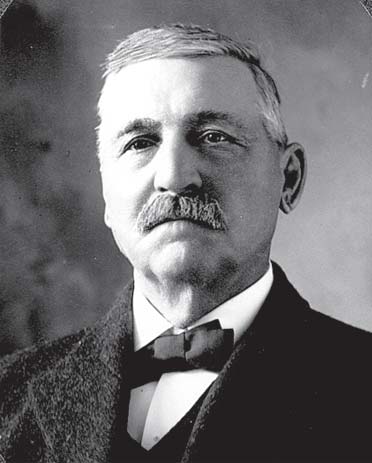Sterland, Walter S.
Place of Birth: Chesterfield
Date of enlistment: 18 November 1872
Age given at enlistment: 21
Rank: Private
Company: M
Location on 25 June 1876: Powder River Depot or With General Terry?
Walter "Johnny Bull" Sterland
- Walter Scott Sterland was born 16 April 1852 on South Street, Chesterfield, Derbyshire, England, son of Henry Sterland, a grocer and tea dealer, and Sarah Scott. He was baptised three weeks later in the 14th century parish church of St Mary and All Saints, famous for its crooked spire. He was therefore only age 20 years-old when he enlisted in the United States Army.
- In 1861 the family was living in Beetwell Street, Chesterfield, next door but one to the Spread Eagle Inn, where Henry Sterland was a running a tallow chandler’s business and sufficiently prosperous to employ a live-in ‘house servant.’ Both Walter and his seven year-old sister, Charlotte, were attending school. Several siblings died in infancy.

Parish Church of St. Mary and All Saints, Chesterfield, famous for its crooked spire.
- Sadly his mother died in the spring of 1864, by which time the family had moved to Holywell Cross in the centre of town.
- Sterland emigrated to the United States at the age of 17 and settled in Chicago. However, on 18 November 1872, it was in Pittsburgh, Pennsylvania, that he was enlisted in the U.S. Army by Lt Calbraith Rodgers and described as being age 21, having blue eyes, light hair, a fair complexion, standing 5′ 5 1/2″ tall, previously employed as a teamster. From Pittsburgh he was sent to the General Mounted Recruiting Service in St. Louis, Missouri, from where he was transferred to Company M, 7th Cavalry, then stationed in Unionville, South Carolina, which was engaged on Reconstruction duty.
- He participated in the Yellowstone Campaign in 1873 and the Black Hills Expedition the following year. Much of his time in the regiment was spent on detached duty as either a butcher or herder.
- According to 7th Cavalry Special Orders No. 41, 9 May 1876, Sterland was assigned as a butcher to Lieutenant Smith. The June 30 Company M muster roll states that he was not present for duty with his company, while the June regimental Return shows that he was stationed at the Powder River Depot. It is also said that while at the Powder River Depot he served as General Terry’s butcher and came to the Bighorn Camp from the Rosebud on the steamer Far West on 22 June 1876. However, a letter to Walter Camp, dated 26 February 1910, thirty-three years after the battle, from Sterland’s first sergeant, John Ryan, maintains that Sterland was with his company at Little Bighorn, a claim that was repeated in a report of the battle published in The Dickinson Press, 5 September 1914, which places Sterland firmly in the thick of the action in the valley fight. It claims: “Mr. Sterland heard Major Reno shout “All who would save themselves, follow me!” and plunged his horse into the river, the bank of which, was some six or eight feet high. All who were not disabled hurried pell-mell across the stream and clambered up the opposite side climbing to a bluff that stood overlooking the valley.” While official army records would seem the more likely to be correct the whereabouts of Sterland on 25 June 1876 must remain uncertain.
- Sterland was promoted to corporal with effect from 18 October 1876; acting company quartermaster sergeant from April to August 1877; was with his company in the Nez Perce campaign the same year; on detached service on the steamer Silver City in October; and discharged on 18 November 1877 at Fort Rice, Dakota Territory, on expiration of five years’ service as a corporal of good character.
- In common with many troopers discharged from the 7th Cavalry Walter Sterland gravitated to Bismarck, where he soon became known as “Johnny Bull,” the popular glass juggler at Sam Whitney’s opera house. On 18 November, 1879 he married 23-year-old Ella Jane Blanchard, born in New York of Canadian parents.
- In August 1880 he purchased the North Star cigar, fruit and news depot at 68 Main Street, from James “Clum” Emmons, steamboat captain, businessman and first chairman of the Burleigh County Board of Commissioners, who gave his name to Emmons County, North Dakota, when it was organized in November 1883.
- (Left) Advertisement in The Bismarck Tribune.
- Walter and Ella Sterland’s only child, Arthur William, was born in Bismarck, December 19, 1881. He died 31 August 1949, in San Mateo, California, leaving a daughter, Thelma, but no sons to carry on the family name.
- Sterland left Bismarck for Dickinson, Stark County, Dakota Territory, in the spring of 1884 where he set up the Montana Meat Market company on Villard Street, in partnership with Samuel Whitney, where there was a great demand for buffalo bones. They also erected a large slaughterhouse and corral near the Heart River just south of the town. For whatever reason, this partnership was soon amicably dissolved and the business carried on by Ella Sterland. Later that year Whitney purchased the Eagle Hotel, which was run by his former barman and partner. Passengers alighting from the train would be approached by Sterland, “a chubby individual, with a white slouched hat,” offering them the best food and most comfortable accommodation in town.
- In the fall of 1885 Walter Sterland took a homestead three miles north of Gladstone and later acquired three additional quarter sections in Stark County creating a mixed farm of over 600 acres. Over the ensuing years he earned a good reputation for the quality of his dairy cattle and the demand for milk and butter was more than he could supply. He marked his cattle and horses with the brand W3. Many years later The Dickinson Press informed its readers that Sterland – “has the finest cottonwood grove to be found anywhere with several hundred trees south of the house set in even rows and carefully cultivated.”
- Walter Sterland would almost certainly have been among the assembled throng in Dickinson on 4 July 1886 to hear future president Theodore Roosevelt make his first major public speech, which was reported in the Jamestown Weekly Alert, 8 July 1886, see below.
- It reads: THEODORE ROOSEVELT delivered the oration at Dickinson, Dak., on the Fourth. It took in the entire country, the present, past and future, the glory and the grandeur of Dakota, and the privilege that would descend to the individual’s children, even to the third and fourth generations, if we were good Dakotans, and made the politicians shape the political destiny of the future with regard to honesty. He declared that it was the duty of every individual to see that public officials were strictly honest. Mr. Roosevelt should know that, like whisky, all Dakota politicians are honest, but some more than others.

Advertisement in 'The Dickinson Press'.
- In September 1890 Sterland was thrown from his horse and, after being dragged for half a mile, was lucky to escape with nothing more than some severe flesh wounds. Three months later, in response to the threat of an Indian outbreak resulting from the Ghost Dance uprising among the Lakota, Gladstone formed an Independent Company of home guard for mutual protection in which Walter Sterland held the rank of first lieutenant. A little over three weeks later, 29 December, the U.S. Army, which included the 7th Cavalry, clashed with Big Foot’s band of Miniconjou at Wounded Knee Creek that resulted in an unacceptably large number of casualties on both sides, and effectively brought the Plans Indian Wars to an end.
- In February 1898, Walter and Ella Sterland adopted (fostered?) “two very bright children” from the Orphanage at Fargo, a boy, age nine, named Hal, and his six-year-old sister they called Ruth. Both children were to take full advantage of the chance they had been given and went on to lead happy and productive lives.
- Sterland received an invitation from the mayor of Monroe, Michigan, in May 1910, to attend the dedication of the statue to General George Armstrong Custer but it seems unlikely that he was able to be there. In October the same year he returned to live in Dickinson and the following month sold his farm near Gladstone to German-born, Julius Hollst.
- In June 1911 Sterland left Dickinson on a two-month trip to England from where he sent a postcard home telling of his safe arrival and that he found the people had changed a great deal in their customs since he left his native land over 30 years before.
- He was back in Dickinson in time to attend the wedding of his adopted daughter, who had reverted to her birth name of Elsie Grim. Her marriage to local farmer, Claude Palmer, which took place on 27 September1911, was conducted by the Rev F. H. Farrand, of the Methodist Episcopal Church, at the groom’s parents’ home on East Villard Street. The fate of Hal Grim (aka Sterland) is not known to this writer.
- In January 1913, in the lobby of the Grand Pacific Hotel in Bismarck, Sterland met Captain Grant Marsh, the legendary skipper of the riverboat Far West, who, thirty-six years before, had brought the wounded from the Battle of the Little Bighorn to Bismarck in record-breaking time. The pair may not have met since the turbulent times of 1876 and, “as one might suppose, they had an enjoyable visit while relating to one another incidents that both had thought were long since forgotten.”
- (Right) Captain Grant Marsh (1834-1916), legendary pilot of the Far West on its record-breaking run 3 July to 5 July 1876.
- As a result of the Indian Wars Pension Act, 1917, Sterland was granted an army pension of $20 a month back dated to 4 March the same year.

Corporal Waleter S. Sterland, Company M. 7th U.S. Cavalry, Indian Wars Pension.
- During the thirty-five years he resided in Stark County Sterland faithfully served his community as Justice of the Peace, City Assessor, Police Magistrate, and Juvenile Commissioner for the Tenth Judicial District.
- Sadly, the old trooper fell victim to cancer of the bladder and died at 8:00 p.m. on 27 August 1922, at St. Alexius Hospital, Bismarck, following an operation for the condition. “His devotion to his duties kept him at work even when the state of his health was critical, yet he bore up uncomplainingly, and when death came he fell fighting like the true soldier he had always been.”
- The next day his remains were taken to Dickinson and laid to rest in the city’s cemetery with full Masonic rites. A distinctive headstone marks the spot.

Sterland family headstone, Dickinson Cemetery, Lot 8, Block P, South 1/2. Author’s collection.
![Sterland Gravestone [2]](https://www.menwithcuster.com/wp-content/uploads/2013/04/Sterland-Gravestone-2.jpg)
Memorial tablet for Walter S. Sterland, which incorrectly states he was “AGE 72” and misspells “CAMPAI[G]N”.
- Ella Blanchard Sterland, who received an army widow’s pension of $11 a month continued to live at 46 West 3rd Street until shortly before her death on 26 April 1924. The Dickinson Press, 6 May 1924 reported – “Blood poisoning and complications caused the death of Mrs. W. S. Sterland, well known Dickinson woman, at the local hospital. Mrs. Sterland had been in good health until a few months ago when she began to fail but her condition was not considered serious. About a week ago she accidentally ran a small splinter of wood into her hand which resulted in the infection that caused her death. She was removed from her home to the hospital and every effort was made to check the course of the poisoning, but her advanced age and weakened condition would not permit her recovery.” She was reunited with her late husband in Dickinson Cemetery.
- It is heart-warming to know that a grocer’s son from Chesterfield, England, liked the American West so much that he made his home in North Dakota, served the local community with such distinction, and finally settled in Dickinson “not more than a half mile from the old Custer trail, over which he campaigned when this spot had nothing upon it but the marks of the passing buffalo herd, the narrow trail of the Indian pony and the vanishing appearance of the stealthy coyote.”
- Note: Quotations taken from The Bismarck Tribune and The Dickinson Press.

Cavalry scout honored by Linda Sailer - The Dickinson Press, 26 May 2012







![Sterland Gravestone [2]](https://www.menwithcuster.com/wp-content/uploads/2013/04/Sterland-Gravestone-2.jpg)


















Comments: